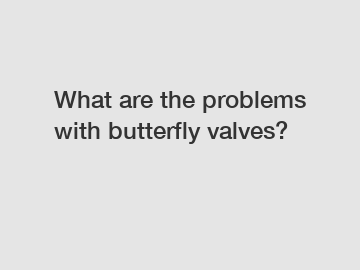What are the problems with butterfly valves?
Butterfly valves are widely used in various industries for controlling the flow of liquids and gases. While they are efficient and cost-effective, they are not without their problems. In this article, we will discuss some common issues that can arise with butterfly valves.
1. Leakage.
One of the primary problems with butterfly valves is leakage. Due to their design, butterfly valves are prone to leakage, especially in high-pressure applications. This can be a significant issue as it can lead to product loss, environmental hazards, and safety risks. It is essential to regularly inspect and maintain butterfly valves to prevent leakage problems.

2. Corrosion.
Another problem with butterfly valves is corrosion. Over time, butterfly valves can corrode due to exposure to aggressive chemicals or harsh environmental conditions. Corrosion can weaken the valve structure, leading to malfunctions and failures. Regular inspections and proper maintenance can help prevent corrosion issues with butterfly valves.
3. Cavitation.
Cavitation is another common problem with butterfly valves. Cavitation occurs when the pressure of the fluid drops significantly, causing vapor bubbles to form and collapse rapidly. This can lead to erosion and damage to the valve components. To prevent cavitation, it is essential to choose the right type of butterfly valve for the application and operate it within the recommended pressure limits.
4. Erosion.
Erosion is a problem that can affect butterfly valves, especially in applications where the flow rate is high or the fluids are abrasive. Erosion can wear down the valve components and affect its performance. To mitigate erosion issues, it is vital to select a butterfly valve made from durable materials and to implement regular maintenance procedures.
5. High operating torque.
Butterfly valves can experience high operating torque, especially in large sizes or high-pressure applications. High operating torque can make it challenging to actuate the valve manually and can put a strain on the valve actuator. It is crucial to choose the right size and type of actuator for the butterfly valve to ensure smooth operation and avoid excessive torque issues.
In conclusion, while butterfly valves are popular for their efficiency and cost-effectiveness, they do have some inherent problems that need to be addressed. Leakage, corrosion, cavitation, erosion, and high operating torque are common issues that can affect the performance of butterfly valves. With proper maintenance, regular inspections, and choosing the right type of butterfly valve for the application, these problems can be minimized, and the valve's longevity can be extended.
If you are facing any issues with butterfly valves or need assistance in selecting the right valve for your application, feel free to contact us. As a reputable valve supplier, we can provide you with expert advice and quality products to meet your specific requirements. Contact us today for all your butterfly valve needs.
If you want to learn more, please visit our website marine valves manufacturers, China rising stem gate valves factory, marine valve suppliers.
202
0
0

Comments
All Comments (0)